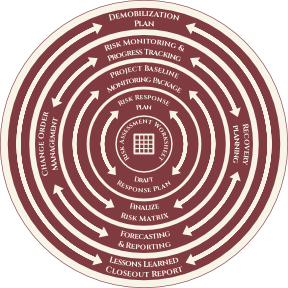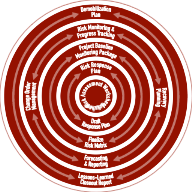Execution Plan
Few Project Management topics can be as confusing and potentially overwhelming as the process of creating a Project Execution Plan. It is a project tool that is used to keep track of and manage the documents, plans and discussions that are created during the planning phase of a project and maintained throughout the project lifecycle. The Project Execution Plan, otherwise known as the PEP, is simply a collection of the various plans and tools needed to manage a project, which sometimes might include processes or procedures that the PM has created specific to their project. The PEP contains not only the documents from the initiating and planning phases (Estimate, Risk Matrix, Contract, Baseline package) of a project but also the execution phase (Schedule, Control tools, Progress Reports) and job closeout (Final report and Lessons Learned). It is a single document repository meant to capture the purpose and essence of a project and to provide a record of the activities associated with the project. Think of it as a daily journal that represents the written record and memory of the project.
Where a PEP can become potentially confusing is in the amount of detail it should contain. PEP's can come in various shapes and sizes and should vary with the risk and complexity of a project. A one-size fits all approach is not recommended. Larger projects generally require more documentation, planning and a greater use of project control tools and company resources. Larger projects also require greater oversight in the form of management control than smaller projects -- which represent less risk and commitment of company resources.
A quick and easy tool for a Project Manager to use in the creation of a PEP is a file template or guide. An effective template should balance the need and purpose of documenting the project with the size and amount of risk in the project. Project Execution Planning should not be done with a shot-gun approach that asks for everything to be detailed in the
PEP. The size and complexity of the project should dictate the level of detail used to document and control the project. Excessive amounts of documentation for smaller projects will not only overwhelm the PM with needless amounts of paperwork and bureaucracy but also adds additional cost to the project. Too little documentation on large projects can be an exposure to potential risks that could impact both the project as well as the company's bottom line.
As an advocate for a tiered or graded-approach to Project Controls, we recommend that Project Execution Planning should always use a graded-approach methodology to develop and retain "the right amount" of detail.
Typical topics that should be core to every PEP include:
Baseline package
Original project scope (Contract documents)
Original project deliverables (Contract documents)
Schedule (detail commensurate with size of project)
Potential risks and planned responses (Risk Matrix)
Original detailed budget
Execution plan (how the job will run)
Identification of stakeholders, project team and responsibilities
List of controls and monitoring tools
Guidelines for addressing changes to scope, schedule, budget
When maintained and tailored to an organization, a PEP can be a valuable asset that will continue to deliver value and benefit to future projects. It will also help guide younger PM's in developing their skills and ability to anticipate, identify, communicate, and document key project variables.


